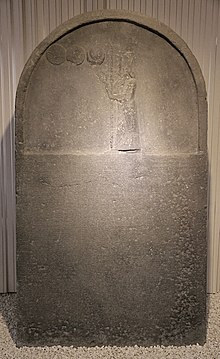Harran
![]()
Charan is a redirect to this article. For the American author see Ram Charan, for the biblical person Haran.
Template:Infobox Place in Turkey/Maintenance/PopulationPlaceMissing
Template:Infobox Place in Turkey/Maintenance/County
Harran (Arabic حران, DMG Ḥarrān; Akkad. Harrānu; sum. URUKASKAL; Greek Κάρραι Karrhai; Latin Carr(h)ae; Hebrew חרן Ḫaran) is a county (İlçe) of the Turkish province of Şanlıurfa in northern Mesopotamia and also a municipality (belediye) of the same name of the Şanlıurfa Büyükşehir Belediyesi (Metropolitan Municipality/Metropolitan Province) created in 2012.
The now insignificant city is the successor settlement of the famous ancient site of the same name, of which many remains have been preserved, especially near the border with Syria. It is also particularly famous for its beehive-shaped houses. Harran is located about 44 km southeast of the provincial capital Şanlıurfa. The population is mainly Arab.
Personalities
- Adad-happe (650 B.C.-546 B.C.), mother of Nabonid and high priestess of Sin
- Al-Battani (850/869-929), Arab astronomer of the early Middle Ages
- Ibn Taimīya (1263-1328), Islamic scholar
- Magnus of Karrhai, Roman historian of the 4th century.
- Nabonid (after 609 B.C.-earliest 539 B.C.), last king of the New Babylonian Empire
- Thabit ibn Qurra (826-901), Arab mathematician and astronomer

Stele of Nabonid from Harran in the Archaeological Museum Şanlıurfa
Questions and Answers
Q: Where is Harran located?
A: Harran is located in the southeast of Turkey, in the district of Şanlıurfa Province.
Q: What was Harran in the past?
A: Harran was a major Mesopotamian commercial, cultural, and religious center, and it is a valuable archaeological site.
Q: Who is often said to have lived in Harran?
A: Abraham is often said to have lived in Harran before he reached Canaan.
Q: Who was Mesopotamian moon-god Sin, and where was his chief home?
A: Mesopotamian moon-god Sin was a deity under the Babylonians and even into Roman times, and Harran was his chief home.
Q: What is Carrhae and why is it famous?
A: Carrhae is an ancient town on the site that doesn't exist anymore, and it is famous for giving its name to the Battle of Carrhae (53 BC), which was fought between the Roman Republic and the Parthian Empire.
Q: What are Harran's ruins from?
A: Harran's ruins are from Roman, Sabian, and Islamic times.
Q: Who surveyed Harran's site and when was an Anglo-Turkish excavation begun?
A: T. E. Lawrence surveyed the site of Harran, and an Anglo-Turkish excavation was begun in 1951.
Search within the encyclopedia